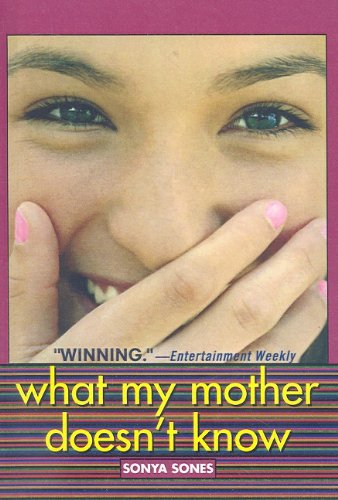
Bibliography
Sones, Sonya. 2001. What My Mother Doesn’t Know.
New York, NY: Simon and Schuster Books for Young Readers. ISBN 9780689841140
Plot Summary
What My Mother Doesn’t Know is a novel that discusses a fifteen-year-old
girl, Sophie, and her experience with friends, family, and the notion of love. Sophie,
a popular student in her school, deals with parents who have a failing marriage
as well as her mother suffering from depression. Sophie is on a quest to find
the one she loves while still keeping true to her identity and looking past the
stereotypes. Sophie finds herself falling in love with her first crush, Dylan, which
then takes a sour turn. We see Sophie learn and develop her own character and
she introduces more crushes. Will Sophie find Mr. Right? Sophie challenges her
thoughts on stereotypes as she searches for the right boy.
Critical Analysis
The free verse
novel is created in short poems on each page that consist of brief words but
evokes emotion as it shares Sophies’ story. The colloquial story is relatable
to many middle school and young adult readers as Sophies. It makes reading
poetry enjoyable while sharing the thoughts of a teenager’s life. The verse
novel develops character growth as Sophie expresses her dilemma and coming to
her own realization of her identity.
The story
created in first person limited-omniscient allows readers to understand the
emotions and feelings of Sophie. Along with that, Sophie being interested in
three different boys while not knowing her fate or their characters creates
mystery and a narrative for readers. This hooks the readers into finding out what
dangers she may face as well as her fate with love.
Overall,
the verse novel would be suitable for young adults and a means to introduce
verse novel poetry as a narrative.
Review excerpts and awards
From Kirkus Reviews: ““Laid out in a series of mostly free-verse
poems, however, the text gets at the emotional state of this girl so completely
and with such intensity that a conventional narrative framework would simply
dilute the effect."
From Booklist: “The
poetry is never pretentious or difficult; on the contrary, the very short,
sometimes rhythmic lines make each page fly. Sophie’s voice is
colloquial and intimate and the discoveries she makes are beyond formula, even
while they are as sweetly romantic as popular song. A natural for
reluctant readers, this will also attract young people who love to read.”
Connections
Read the sequel What
My Girlfriend Doesn’t Know by Sonya Sones
Connections
in the classroom
Compare/Contrast
What My Mother Doesn’t Know and What My Girlfriend Doesn’t Know. Share the two
different perspectives: Sophies and Robin/Murphy.
Students
can create their own form of journaling and practice free verse poetry while
expressing and conveying their emotions.

